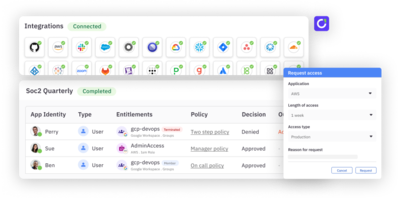Identity security is a critical component of an organization’s overall cybersecurity strategy. By implementing strong identity security measures, organizations can protect their data, maintain compliance with regulations, and reduce the risk of costly security breaches. |
What is identity security?
Identity security refers to the comprehensive policies, technologies, and procedures designed to ensure that only authorized individuals have access to sensitive information and resources within an organization. It aims to protect digital identities from unauthorized access, theft, and misuse, thereby safeguarding the organization’s data and systems.
Key terms:
- Policies. These are the rules and guidelines that an organization puts in place to manage and secure identities. Policies govern how identities are created, maintained, and retired, as well as how access rights are assigned and reviewed. For example, a policy might stipulate that all employees must use complex passwords and change them every 90 days.
- Technologies. These are systems that are employed to enforce identity security policies and provide the necessary tools to manage identities. These technologies typically include Identity and Access Management (IAM) systems, biometric verification, multi-factor authentication (MFA), and single sign-on (SSO).
- Procedures. These are the specific steps and processes that are followed to implement identity security policies and technologies. Procedures might include:
User provisioning and deprovisioning. The process of creating and removing user accounts and assigning access rights as employees join, move within, or leave the organization.
Regular access reviews. Periodic checks to ensure that users have appropriate access rights based on their roles and responsibilities.
Incident response. Defined steps for detecting, responding to, and recovering from identity-related security incidents.
The difference between identity security and identity management
Identity security focuses heavily on the security aspect of identity management, including the prevention of unauthorized access and the monitoring of identity-related security events.
On the other hand, identity management (often termed as “identity and access management” or “IAM”) is a broader framework that includes the security components and the administration aspects related to managing user identities across systems.
IAM systems provide the tools necessary to create, maintain, and retire user identities and profiles throughout the user lifecycle. IAM focuses more on efficiency and resource access, ensuring that the right users have the appropriate access to resources at the right times and for the right reasons.
Aspect | Identity Security | Identity Management |
Primary Focus | Ensures that identities are secured against unauthorized access. | Manages identities across different systems and ensures appropriate access control. |
Key Features | Multi-factor authentication, behavioral analytics, and security event monitoring | User role management, access control policies, and directory services |
Goal | To prevent unauthorized access and ensure the confidentiality and integrity of data. | To streamline and manage user access efficiently across an organization’s systems. |
Tools and Technologies | Advanced security tools like intrusion detection systems, encryption, and tokenization. | Systems for role-based access control, single sign-on, and administrative tools for user lifecycle management. |
Benefits | Enhances security posture and reduces risk of data breaches | Improves operational efficiency and ensures compliance with regulatory standards |
Challenges | Complexity of security implementations and continuous monitoring and response needed | Managing large volumes of identities and integration with various IT systems |
Why is identity security important for your organization?
Identity security serves as the foundational framework for safeguarding your organization’s data, resources, and user base by ensuring that only verified individuals have the ability to access sensitive information. It’s integral to a comprehensive cybersecurity strategy. Here’s why:
Mitigates risks of data breaches
A robust identity security protocol establishes a strong defense against potential data breaches. By incorporating measures such as multi-factor authentication (MFA) and stringent access controls (e.g., RBAC & ABAC), you make it significantly harder for attackers to steal login credentials and infiltrate your systems.
For example, MFA adds an extra layer of security by requiring users to identify themselves through multiple means of authentication before gaining access.
This verification process often includes:
- Something you know. Typically a password or PIN.
- Something you have. A physical device like a smartphone, hardware token, or a smart card.
- Something you are. Biometric verification such as fingerprints, facial recognition, or retinal scans.
By combining these factors, MFA makes it much harder for unauthorized users to access systems even if one factor (e.g., a password) is compromised.
This approach reduces the likelihood of unauthorized access and ensures that any breach requires multiple points of failure, significantly increasing security resilience.
Related → What Is Role-Based Access Control (RBAC)?
Enforces zero trust architecture
Zero trust architecture (ZTA) operates on the principle that no user or device, whether inside or outside the network, should be trusted by default. Instead, continuous verification is required.
- User Verification. Every access request is continuously authenticated, authorized, and encrypted regardless of the user’s location.
- Device verification. The security posture of devices attempting to access resources is regularly assessed. This includes checking for compliance with security policies, such as having up-to-date antivirus software, proper encryption, and the latest security patches.
- Behavioral analysis. User behavior is monitored for anomalies that could indicate a potential security threat. For example, if a user suddenly starts accessing resources at odd hours or from unusual locations, this could trigger an additional verification process.
Additionally, in a zero trust environment, even if an attacker gains access to the network, the architecture is designed to minimize the potential damage through
- Micro-segmentation. The network is divided into smaller, isolated segments, each with its own access controls. This limits the lateral movement of attackers within the network.
- The principle of least privilege (PoLP). Users are granted the minimum level of access necessary to perform their job functions. This principle ensures that if an account is compromised, the damage is limited to the specific resources that account has access to.
- Continuous monitoring and analytics. Real-time monitoring and advanced analytics are employed to detect and respond to suspicious activities quickly, thereby containing potential breaches before they escalate.
Related → Best Practices for Privileged Access Management for the Cloud
Protects identities and IAM systems
Beyond protecting data, identity security is crucial for protecting identities themselves, including sensitive user details such as usernames and passwords. It also extends to the broader protection of identity and access management (IAM) systems, which are essential for controlling and monitoring user access rights and roles.
In addition, robust identity security practices help in enforcing compliance with various regulatory requirements. Many industries are governed by strict data protection standards, such as GDPR in Europe, HIPAA in the healthcare sector, and PCI DSS for payment data.
Effective identity security measures ensure that organizations meet these compliance mandates, avoiding hefty fines and reputational damage.
Enhances IAM system integrity
Software vulnerabilities can be exploited to gain unauthorized access to systems. Regularly patching these vulnerabilities helps maintain the integrity of your systems.
Vulnerability management programs. Implementing a comprehensive vulnerability management program that includes regular scanning, assessment, and remediation of vulnerabilities.
Automated patching. Utilizing automated tools to apply patches and updates promptly, minimizing the window of exposure to potential exploits.
Vendor coordination. Working closely with software vendors to stay informed about new vulnerabilities and recommended patches.
Challenges in identity security
Evolving cyber threats
As the tech evolves, so do the methods employed by cybercriminals. Phishing attacks, malware, and ransomware have become more advanced, making it harder for traditional security measures to keep pace. Attackers are also using artificial intelligence and machine learning to automate attacks and increase their efficacy, posing significant risks to identity security.
💡Real-life incident → In 2019, criminals used AI-generated audio to mimic the voice of a CEO and successfully requested a fraudulent wire transfer of €220,000 from a UK-based energy firm [*].
Insider threats
Not all threats come from outside an organization. Insider threats, whether malicious or due to negligence, are a significant risk.
Employees or contractors who have access to sensitive systems can misuse their credentials to steal information or unintentionally expose data through careless actions. The challenge is to manage these risks without overly restricting legitimate access.
💡Real-life incident → Reality Leigh Winner, a contractor at the NSA, leaked highly classified information by misusing her access to sensitive data [*].
Fragmented identity data
Many organizations use a range of applications and services, each with its own identity management controls. This fragmentation can lead to inconsistencies in how identity data is handled and protected, increasing the risk of unauthorized access and data breaches.
💡Real-life incident → A while back, Anthem Inc. suffered a massive data breach, impacting nearly 80 million records. This breach was partly attributed to fragmented identity systems across its network [*].
Compliance with regulations
There are numerous regulations governing data protection and privacy, such as GDPR, HIPAA, and CCPA. Each regulation requires organizations to adopt specific measures to protect identity data, making compliance a complex and ongoing challenge. Non-compliance can result in heavy fines and damage to an organization’s reputation.
💡Real-life incident → Facebook was fined $5 billion by the FTC for privacy violations that contradicted the assurances given to users about their data security [*].
Balancing security with user experience
There is often a tension between tightening security measures and maintaining a smooth user experience. Overly stringent security controls can frustrate users and hinder productivity, whereas lenient controls can expose the organization to risks. Finding the right balance that aligns with user expectations without compromising security is a key challenge.
💡Real-life incident → HSBC’s introduction of voice recognition software to enhance security faced a backlash as users found it cumbersome and invasive, impacting customer satisfaction [*].
Top features of identity security systems
Implementing a robust identity security system is essential for protecting sensitive information and ensuring that only authorized individuals can access critical resources.
Here are the top features of effective identity security systems:
Supports zero trust architecture
As discussed earlier, zero trust architecture (ZTA) is a security model that operates on the principle of “never trust, always verify.”
It assumes that threats can exist both inside and outside the network and so continuously verifies the identity and context of users and devices. Identity security systems that support ZTA offer several key features:
- Multi-factor authentication (MFA). MFA enhances security by adding an extra layer of protection beyond just usernames and passwords, making it significantly harder for attackers to gain unauthorized access even if they have obtained a user’s password.
- Conditional access. This allows organizations to set specific conditions under which access to resources is granted. These conditions can be based on factors such as user location, device compliance, risk level, and the type of application being accessed.
- Least privilege access control. By limiting the number of users who have access to sensitive information and critical systems, organizations minimize their attack surface area. This reduces the potential impact of compromised credentials and insider threats.
Related → What Is Authentication vs. Authorization?
Achieves Quick Value
Effective identity security systems are designed to be rapidly deployed and to provide immediate benefits to organizations. Key features that contribute to achieving quick value include:
Pre-built integrations. Reduces deployment time and complexity by allowing organizations to quickly integrate identity security measures without extensive customization. This accelerates the time-to-value and ensures that security improvements can be realized swiftly.
Cloud-based deployment. Offers faster deployment and easier scalability compared to on-premise solutions. Cloud-based systems can be updated automatically, ensuring that the latest security features and patches are always in place. Additionally, cloud solutions often have lower upfront costs and require less maintenance.
User-friendly interfaces. Enhances user adoption and reduces the learning curve, allowing security teams to manage identities and access controls more efficiently. User-friendly interfaces also improve the overall user experience, encouraging consistent use of security features.
Protection at domain controller and endpoints
Comprehensive identity security systems provide protection at the user level and also at critical infrastructure points such as domain controllers and endpoints. This ensures a solid security posture.
Endpoint security modules. Protects against threats that target user devices, such as malware and unauthorized access. By monitoring and securing endpoints, organizations can detect suspicious activity early and prevent breaches before they can cause significant damage.
Active Directory protection. For organizations using Active Directory (AD), protecting it from unauthorized access and modifications can prevent attackers from gaining elevated privileges or manipulating user accounts. This includes monitoring AD for suspicious changes and implementing additional security controls around AD access.
Identity security use cases
Preventing data breaches
Data breaches occur when sensitive, protected, or confidential data is accessed or disclosed without authorization. Preventing data breaches is crucial for protecting personal and organizational information.
Application:
A financial institution uses multi-factor authentication (MFA) and continuous monitoring to safeguard customer data. Even if a password is stolen, the additional authentication steps prevent unauthorized access, significantly reducing the risk of a data breach.
💡Pro Tip → Adopt a layered approach that includes several identity security measures, policy enforcement, and regular staff training. Ensure that your security measures are updated regularly and conduct routine audits to identify and rectify potential vulnerabilities in your system.
Enforcing least privilege access control
Least privilege access control is a security principle that restricts users’ access rights to the minimum necessary to perform their job functions. This approach reduces the risk of accidental or malicious misuse of sensitive information, making it a key strategy in identity security.
Application:
A technology company assigns role-based access controls to its employees. A junior developer needs access to specific development environments but not to the production database. The system ensures they have just enough access to fulfill their tasks without exposing critical systems to unnecessary risk.
💡Pro Tip → Regularly review and update access permissions as roles or job functions change. Use automated tools to manage access rights efficiently and ensure compliance with the least privilege policy.
Related → 7 Principles for Least Privilege Access Implementation
Privileged access management (PAM)
Privileged access management (PAM) refers to controlling and monitoring access to an organization’s critical systems and resources by privileged users, such as administrators and IT personnel. PAM prevents unauthorized access and reduces the risk of insider threats by managing and auditing privileged accounts.
Application:
A large corporation uses PAM solutions to manage credentials and session activities for their network administrators. This system ensures that all privileged sessions are recorded and audited, and it provides the ability to terminate any session that appears to be performing unauthorized actions.
💡Pro Tip → Implement a comprehensive PAM strategy that includes regular password rotations, multi-factor authentication for privileged accounts, and continuous monitoring of privileged activities. Educate privileged users about security best practices to enhance the effectiveness of your PAM system.
Enabling secure cloud adoption
Secure cloud adoption involves implementing appropriate security measures to protect data, applications, and infrastructure when transitioning to cloud computing. This practice ensures that cloud environments are efficient, scalable, and secure from unauthorized access and data breaches.
Application:
An e-commerce company moves its customer data and transaction processing systems to a cloud service. To secure its data, the company uses encryption, deploys a cloud access security broker (CASB) to monitor data traffic, and implements strong identity and access management policies.
💡Pro Tip → When adopting cloud services, select a cloud provider that offers comprehensive security features compliant with industry standards. Regularly conduct security assessments and use tools like CASBs to monitor and control the traffic between your on-premises environments and the cloud to ensure that all data remains secure.
Simplifying user onboarding and offboarding
Simplifying user onboarding and offboarding is all about streamlining the processes of granting and revoking access to systems and resources for employees as they join or leave an organization.
Application:
A retail company automates its employee onboarding and offboarding processes using an identity management system. When a new employee joins, the system automatically assigns access based on their role. Similarly, when an employee leaves, the system immediately revokes all access, preventing any potential unauthorized access.
💡Pro Tip → Implement an identity management solution that automates the onboarding and offboarding processes. This not only reduces administrative burden but also minimizes the risk of human error and ensures that access rights are always up to date. Regular audits of user access rights can further enhance security.
Improving compliance with regulations
Improving compliance with regulations involves adopting security practices and protocols that align with legal and regulatory requirements specific to an industry. This ensures that an organization can protect sensitive information and avoid penalties associated with non-compliance.
Application:
A financial services firm implements data protection policies that comply with the General Data Protection Regulation (GDPR). They utilize tools for data classification, encryption, and access control to ensure that personal data is handled according to the strictest privacy standards.
💡Pro Tip → Stay informed about the latest regulatory requirements in your industry and integrate compliance into your security strategy from the start. Use compliance management software to automate compliance tracking and reporting, making it easier to maintain and prove compliance with various regulations.
Implementing identity security in your organization [a 7-step process]
- Step 1: Assess current security posture
- Step 2: Define identity security requirements
- Step 3: Select identity security solutions
- Step 4: Implement identity management infrastructure
- Step 5: Enforce access controls
- Step 6: Monitor and audit
- Step 7: Create an incident response and recovery plan
Step 1: Assess current security posture
- Conduct a security audit. Start by performing a comprehensive security audit of your IT environment. This should include all hardware, software, networks, and data processes. Use tools such as vulnerability scanners and penetration testing to identify weak spots in your infrastructure.
- Review access protocols. Examine how data access is currently managed. Look for outdated protocols, weak authentication methods, or excessive permissions that could expose your systems to unauthorized access.
- Examine external and internal threats. Consider both external threats, such as hackers and malware, and internal threats, such as employee error or insider threats. This helps in understanding all possible vulnerabilities that might not be immediately obvious.
💡Pro Tip → After identifying vulnerabilities, evaluate the potential impact and likelihood of each risk. Use a structured approach like a risk matrix to categorize and prioritize these risks. This will help in focusing efforts on the most critical vulnerabilities first.
Step 2: Define identity security requirements
- Conduct a user access review. Start by reviewing who currently has access to what within your organization. This involves auditing all user accounts and their access rights to determine if they align with the individual’s job requirements.
- Identify sensitive data and systems. Pinpoint which data and systems are critical or sensitive and therefore require stricter access controls. This could include financial records, personal employee information, or proprietary company data.
Once you’re done, categorize users based on their role, department, or the sensitivity of the data they need to access. This helps in creating more tailored access policies.
For your policy development:
- Create an IAM framework. Develop an identity and access management (IAM) framework that outlines how identities will be managed and secured across your organization. This should include guidelines on how to handle user identities from creation to deletion.
- Draft access control policies. Write detailed access control policies that include criteria for who can access different types of information and under what circumstances. Ensure these policies support the principle of least privilege and role-based access control.
💡Pro Tip → Establish policies regarding password complexity, rotation, and reset protocols. Also, consider policies for using multi-factor authentication to enhance security further.
Related → User Access Reviews: Process & Best Practices Checklist
Step 3: Select identity security solutions
- Identify solution requirements. Start by listing the specific needs that your identity security solution must meet, such as support for multi-factor authentication, integration with existing systems, scalability, and compliance with industry regulations.
- Research available solutions. Look into various identity management technologies including identity and access management (IAM), privileged access management (PAM), and identity governance and administration (IGA) solutions. Evaluate each solution’s features against your specific needs.
- Proof of concept. For promising solutions, consider conducting a proof of concept (POC) to see how well the technology integrates with your environment and meets your requirements in a real-world scenario. This is to minimize disruptions and decrease the likelihood of security gaps.
Develop criteria for selecting vendors. These should include aspects like vendor reputation, support and maintenance services, cost, user reviews, and the ability to customize solutions.
💡Pro Tip → Request detailed proposals and live demos from potential vendors to better understand how their solutions work and how they could benefit your organization. It’s important that the preferred solution can adapt to the growing needs of your organization.
Related → What Is Identity Governance and Administration (IGA) vs. Privileged Access Management (PAM)?
Step 4: Implement identity management infrastructure
- Setup and configuration
- Begin by deploying the hardware and software components of the selected identity management solution. This could involve setting up servers, installing software, and configuring network connections.
- Integrate the identity management solution with existing IT systems, such as HR databases, email systems, and other critical business applications to ensure seamless synchronization of user data across platforms.
- Configure the identity management system with the previously defined access control policies and rules. This includes setting up user roles, permission levels, and authentication requirements.
- User registration
- Register all existing users in the new system. This involves collecting necessary user data, verifying identities, and assigning initial access permissions based on roles.
- Set up authentication mechanisms for all users. Depending on the system, this might include password setups, security questions, or biometric data enrollment for multi-factor authentication.
- Establish a protocol for onboarding new users as they join the organization, ensuring that identity verification and access granting are handled efficiently and securely.
💡Pro Tip → Conduct a user acceptance testing (UAT) to ensure that the identity management system functions as expected in real-world scenarios. This includes verifying that access controls are working correctly and that the authentication processes are secure.
Step 5: Enforce access controls
- Implement a RBAC System. Set up a role-based access control system within your identity management infrastructure. Configure the roles with their respective access rights to systems, data, and resources.
- Identify conflict areas. Identify and document areas where duties should be segregated to prevent conflicts of interest or fraud.
- For example, the person who requests a financial transaction should not be the same person who approves it.
- Enforce SoD Policies. Implement controls in the identity management system to enforce SoD policies, preventing a single user from performing conflicting duties.
💡Pro Tip → Perform ad hoc checks in response to security alerts or when significant changes in roles or access rights occur.
Step 6: Monitor and audit
- Implement monitoring tools. Deploy advanced security monitoring tools that can track and analyze user activities and access patterns in real time. These tools should be capable of detecting anomalies that could indicate a security breach, such as unusual login times or locations, and excessive access attempts.
- Automated alerts. Set up automated alerts to notify security personnel immediately when potential security incidents occur. This enables swift action to mitigate any threats before they can cause significant damage.
- Schedule regular audits. Establish a regular schedule for auditing identity and access management practices. These audits should check for compliance with policies, proper implementation of access controls, and the effectiveness of security measures.
- Audit scope and checklists. Define the scope of each audit with detailed checklists that cover all aspects of identity security, including user access levels, authentication methods, and policy adherence.
💡Pro Tip → Consider involving third-party security firms to conduct independent audits. This can provide an unbiased assessment of your security posture and help identify vulnerabilities that internal teams might overlook.
Step 7: Create an incident response and recovery plan
Create a detailed incident response plan specifically tailored to identity security breaches. This plan should outline clear procedures for detecting, responding to, and recovering from security incidents.
Below are the six phases of an incident response plan:
- Preparation. Before any incident occurs, prepare your team and systems. This involves training staff, establishing an incident response team, and equipping them with the necessary tools and authority to act decisively.
- Identification. Detect potential security incidents promptly. This could involve monitoring systems for unusual activity, setting up intrusion detection systems, and using advanced analytics to identify anomalies that may indicate a breach.
- Immediate containment. When a breach occurs, contain it quickly to minimize damage. Actions might include disabling affected accounts, changing passwords, or segmenting the network to isolate compromised areas.
- Eradication of threats. After containment, focus on completely removing the threat. This step involves deleting malicious files, revoking unauthorized accesses, updating security patches, and ensuring that all malware is eradicated from the system.
- System recovery. Restore affected systems and data from backups. Before reintegration into the network, thoroughly check restored systems to ensure they are free from threats and fully functional.
- Post-incident review. After the incident, conduct a detailed review of the event and your response to it. Analyze what happened, how it was handled, and what could be improved. Update the incident response plan based on these insights to strengthen future responses.
💡Pro Tip → Conduct regular simulation drills to test the effectiveness of the incident response plan. These drills should mimic various scenarios of identity theft or data breaches to ensure the team can respond swiftly and effectively. After each drill, gather feedback to identify any weaknesses in the response plan. Use this feedback to refine and improve the plan continuously.
ConductorOne — Identity security for the modern enterprise
As a leading security platform, ConductorOne empowers organizations to take a proactive approach to identity security, safeguarding your valuable data and resources.
It delivers a suite of tools designed to address the complexities of modern digital environments, ensuring that security is both comprehensive and non-intrusive.
Why choose ConductorOne for enhanced identity security?
Achieve zero standing privileges without sacrificing productivity
ConductorOne is designed to minimize security risks without hindering workflow efficiency. Using ConductorOne, you can achieve zero standing privileges (ZSP), ensuring that permissions are granted only when needed and automatically revoked when not in use, thereby reducing your overall attack surface.
This approach eliminates unnecessary access rights without overloading IT teams or preventing employees from performing their duties effectively.
Simplify access control with modern IGA
ConductorOne offers a comprehensive solution for access control that simplifies the management of user identities and their permissions across your organization’s IT environment.
It provides a unified platform for automating access reviews, managing identity lifecycles, and enforcing policy-driven access controls. The platform also supports self-service access requests, enhancing user autonomy while ensuring that all changes adhere to strict security policies.
Secure privileged access to infrastructure
Protecting your organization’s most sensitive infrastructure is important. ConductorOne addresses this by enabling just-in-time access to both cloud and on-premises environments, ensuring that privileged access is granted only as needed and closely monitored.
The platform provides comprehensive visibility of all access events and robust account lifecycle management to prevent unauthorized access and potential breaches.
Reduce risk by eliminating shadow apps
ConductorOne helps secure your IT environment from the risks associated with shadow IT by detecting, monitoring, and allowing you to manage unauthorized applications.
This visibility allows organizations to regain control over their SaaS applications, reducing potential security vulnerabilities and ensuring compliance with corporate policies.
Secure your cloud infrastructure with CIEM
ConductorOne’s CIEM capabilities allow you to manage and secure entitlements across various cloud platforms and data warehouses effectively. By centralizing control over these entitlements, ConductorOne ensures that only the right entities have the necessary access, significantly reducing the risk of data breaches and ensuring compliance with regulatory standards.
Secure sensitive resources with just-in-time access
Building on the principle of zero standing privileges, ConductorOne enhances security by providing just-in-time (JIT) access to sensitive applications, infrastructure, and resources, with configurable policies for break-glass and on-call access.
This allows users to request access as needed and receive it promptly without the risks associated with permanent privileges.
Compliance made efficient
With ConductorOne, compliance processes become less cumbersome and more automated. The platform automates user access reviews, proactively detects potential access risks and access conflicts, and generates compliance reports with a single click. This makes the audit process more manageable, ensuring continuous compliance with industry standards and regulations.
Choosing ConductorOne means investing in a scalable, efficient solution that meets modern identity security needs and also adapts to future challenges.
ACCESS CONTROLS FOR THE MODERN ENTERPRISE
Secure your company with complete access visibility, just-in-time access, self-service requests, and automated compliance—all from a single platform.




